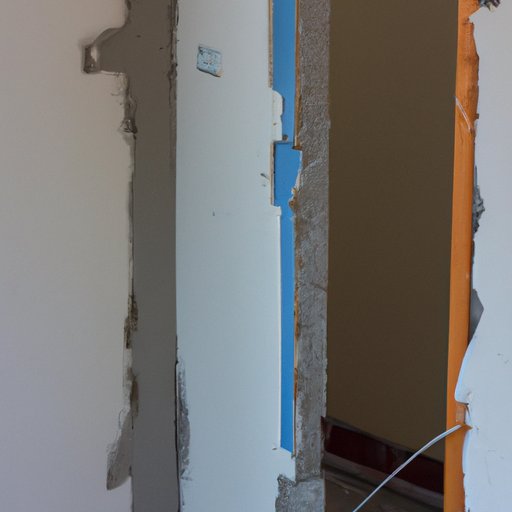Introduction
Load-bearing walls are essential to architectural integrity. They carry the weight of a building, supporting the roof, upper floors, and everything in between. Identifying a load-bearing wall is crucial to ensure safety and avoid causing damage to the home. In this article, we will provide you with a comprehensive guide on how to tell if a wall is load-bearing, so you can make informed decisions when it comes to home renovation and decorating.
Types of Walls in a Home
Before identifying if a wall is load-bearing, it’s important to understand the different types of walls in a home. Most homes have a combination of load-bearing and non-load bearing walls. Exterior walls are almost always load-bearing, while interior walls can be either load-bearing or non-load bearing.
Non-load bearing walls are usually thin and made from materials such as drywall or plasterboard. They do not support any weight, and removing them won’t affect the structure of the home.
Load-bearing walls are thicker and sturdier than non-load bearing walls. They support floors, roofs, and other structural elements of the house. Load-bearing walls are typically placed in the center of the house and perpendicular to the joists, although they can also run parallel to the joists.
Some other factors that can help identify if a wall is load-bearing are the location of the wall, the structure of the home, and whether the wall continues through the roof structure.
How to Check for Load-Bearing Walls
Checking for load-bearing walls requires a few simple steps that can help identify the location, size, and composition of the wall. Here’s a step-by-step guide:
- Check the blueprints or consult a structural engineer to determine if a wall is load-bearing. This is especially important if the wall is located in a multi-story home.
- If blueprints are not available, look at the thickness of the wall. Load-bearing walls are usually thicker than non-load bearing walls, and they may have additional layers of plaster or drywall.
- Check the location of the wall. Load-bearing walls are usually located in the center of a house and are perpendicular to the joists.
- Check the structure above the wall. If the wall is located below a heavy roof beam or wall, it’s likely to be load-bearing.
- Look for clues in the basement or crawlspace. The foundation walls should run parallel to the floor joists. If the wall in question runs perpendicular to the joists below, it’s likely that it’s load-bearing.
- Check the attic or crawl space. If the wall continues through the roof structure, it’s an indication that it’s load-bearing.
It’s important to note that the side-by-side configuration of open rooms may obscure the true layout of the home and require further examination. Consulting a professional may be the best course of action if you have any concerns, as they can help determine if a wall is load-bearing correctly.
When to Consult a Professional
Although checking for load-bearing walls can be done without professional help, there are times when it’s best to involve an expert. If you’re planning on removing a wall, it’s best to consult a structural engineer or contractor before proceeding, especially if the wall in question bears any weight. Common indicators of weight-bearing walls include steel beams in the ceiling, diagonal framing in the wall, and steel plates that indicate a wall is tied into framing.
If you’re renovating an older home, it’s best to seek advice on the structural integrity of the home. In older homes, load-bearing walls may appear similar in construction to non-load bearing walls. Older homes may have experienced structural damage, settling, or rot, which can weaken the walls’ load-bearing capacity. Experienced contractors or structural engineers should be contacted to evaluate the strength of the wall.
Common Myths About Load-Bearing Walls
There are several common myths about load-bearing walls that can create confusion, fuel speculation, and lead to unnecessary damage and costs. Here are a few myths debunked:
- Walls between windows prove that they are safe to remove. This is not true. The wall in question could still provide crucial structural support, and improperly removing it can lead to serious problems.
- Walls parallel to the floor joists are always non-load bearing. This is not always the case. Some homes may have a different framing structure, making this not an accurate measurement.
- If a wall has no visible studs, it’s not load-bearing. This is not true. Load-bearing walls may have concealed framing or use different techniques that hide the studs.
It’s always best to consult a professional before making any alterations to your home structure.
Modifying Homes With Load-Bearing Walls
If you’re interested in adding more natural light to your home, there are ways to do it without removing structural walls. Installing a skylight or windows within an adjoining wall is one way to brighten the room without compromising the structure of your home. You may also consider using light-emitting diodes or LED lighting to create ambiance and color in your spaces.
Conclusion
Identifying a load-bearing wall is essential to ensure your home’s structural integrity and avoid causing damage. This guide has outlined several ways to help identify load-bearing walls and debunked some common myths. If you’re planning to modify your home in any way, it’s best to consult a professional to ensure the work is done correctly and safely.
